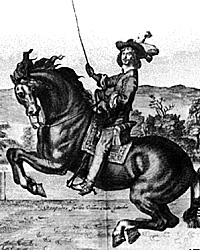![]()
 THE CAMPAIGN
THE CAMPAIGN
After his victory at Adwalton Moor in May 1643, the Earl of Newcastle and his Northern Royalists controlled most of Yorkshire with the exception of Hull. In June, Newcastle began to threaten the Eastern Association by probing into Lincolnshire, sending his Lieutenant-General of Horse, Charles Cavendish, to co-operate with the Royalists of the East Midlands and the Newark garrison under Colonel Sir John Henderson.
At right, the Earl of Newcastle.
The Royalists scored a number of successes, which led to elements of the Army of the Eastern
Association moving north to counter them. The continued resistance of Hull prevented Newcastle
from turning his full attention southwards, and or 20th July Lord Willoughby of Parham took
Gainsborough, cutting Newcastle's communications with Newark. A week later, the Parliamentarians had another success, when a force under Sir John Meldrum and Oliver Cromwell defeated and killed Cavendish near Gainsborough.
However the situation temporarily swung back in the Royalists' favour when Newcastle brought
his main army south of the Humber, retaking Gainsborough and occupying Lincoln. But the
continued threat to his rear presented by Hull caused him to shift his attention back to reducing that garrison, leaving Sir William Widdrington as Colonel General of Lincolnshire, Nottinghamshire and Rutland.
Anxious to take action to relieve the pressure on Hull, Manchester decided to move against the small Royalist garrison at Bolingbroke Castle, 15 miles north of Boston, and laid siege to it on October 9th. Sir Thomas Fairfax was sent to occupy Horncastle with detached outposts at
Edlington and Thimbleby to watch for Royalist countermoves.
These soon came. Newcastle, realising the threat presented by the united Parliamentarian forces, had ordered Widdrington and Henderson to draw off as many troops as could be spared from the garrisons of Lincoln, Gainsborough and Newark, hopefully to be reinforced by some of
Lord Hasting's men from the East Midlands, and then to protect Bolingbroke.
The Royalist commanders were short of troops, particularly as Hastings probably did not despatch any reinforcements in time, but managed to muster at Lincoln a force of about 1,500-2,000 horse and about 750 dragoons. It is not clear whether Widdrington or Henderson was in
command. Despite Widdrington's seniority, most contemporary accounts name Henderson.
On October 10th the combined Royalist force set off for the Horncastle. They were able to surprise some of Fairfax's outposts, and a good deal of skirmishing went on all day as the Parliamentarians fell back on Horncastle, and then to a general rendezvous which Manchester called at Stickney, just southwest of Bolingbroke.
From here on the morning of October 11th, the Parliamentarians set out for Horncastle, determined on bringing the enemy to battle Cromwell, at the Council of War held prior to the march beginning, apparently opposed seeking action on the grounds that the horses were tired, but was overruled by the normally passive Manchester.
The Royalists had resumed their march towards Bolingbroke, and the two armies sighted
each other about half way between there and Horncastle, near the village of Winceby.
The Armies of Winceby This article appears in MagWeb (Magazine Web) on the Internet World Wide Web. On 26th September, realising that retaining cavalry in besieged Hull was merely to waste
provisions, Sir Thomas Fairfax and 26 troops of Yorkshire horse successfully crossed the Humber River and made the risky journey south to link up with the Eastern Association forces. The Earl of Manchester, appointed to command the Army of the Eastern Association in August, on 16th September recaptured their valuable port of Lynn, which had fallen to a Royalist coup, and advanced to Boston, where he linked up with Fairfax and some of his own horse under their Lieutenant-General, Oliver Cromwell. Their combined force reportedly totalled 6,000 men, including 1,500 horse.
On 26th September, realising that retaining cavalry in besieged Hull was merely to waste
provisions, Sir Thomas Fairfax and 26 troops of Yorkshire horse successfully crossed the Humber River and made the risky journey south to link up with the Eastern Association forces. The Earl of Manchester, appointed to command the Army of the Eastern Association in August, on 16th September recaptured their valuable port of Lynn, which had fallen to a Royalist coup, and advanced to Boston, where he linked up with Fairfax and some of his own horse under their Lieutenant-General, Oliver Cromwell. Their combined force reportedly totalled 6,000 men, including 1,500 horse.
The Battle of Winceby and Map
Back to Battlefields Vol. 1 Issue 4 Table of Contents
© Copyright 1996 by Partizan Press.
Other military history articles and gaming articles are available at http://www.magweb.com